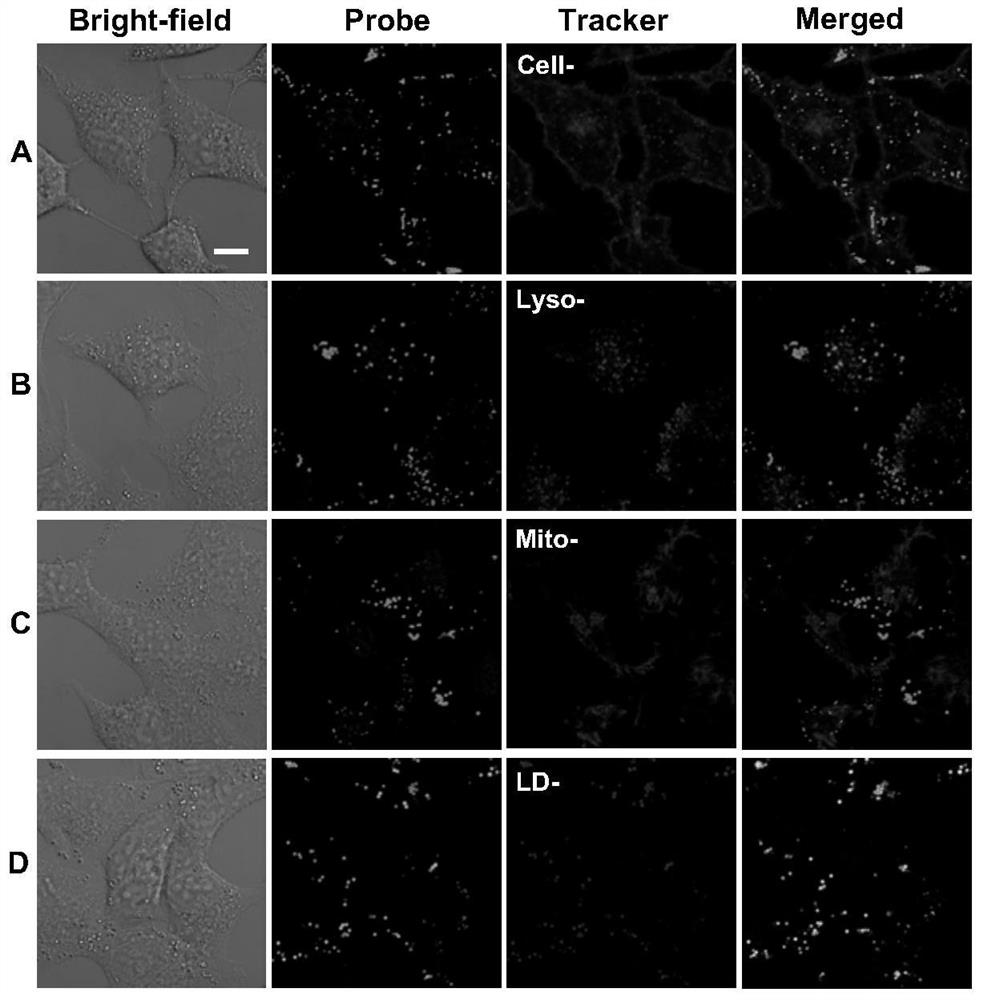A fluorescent dye specifically targeting intracellular lipid droplets and its preparation method and use
A fluorescent dye and cell-targeting technology, which is applied in the field of fluorescent dyes specifically targeting intracellular lipid droplets and its preparation, can solve the problems of difficult to trace the physiological process of lipid droplets, complex dye synthesis process, dye self-absorption, etc. , to achieve low cytotoxicity, low fluorescence background, and easy purification
- Summary
- Abstract
- Description
- Claims
- Application Information
AI Technical Summary
Problems solved by technology
Method used
Image
Examples
Embodiment 1
[0037] Embodiment 1: the synthesis of dye dansyl-morpholine (DNS-M)
[0038]
[0039] Dissolve 81.0mg of morpholine (0.927mmol) and 128.1mg of anhydrous potassium carbonate (0.927mmol) in 10mL of anhydrous acetonitrile, and stir at room temperature for 30min. 10 mL of anhydrous acetonitrile solution dissolved with 250 mg of dansyl chloride (0.927 mmol) was added dropwise to the above reaction system, and the stirring reaction was continued at room temperature for 3 h. After the reaction was completed, the potassium carbonate powder was removed by suction filtration, and the acetonitrile was removed with a vacuum rotary evaporator. The obtained green powder was purified by column chromatography to obtain the target product DNS-M, and the eluent was CH 2 Cl 2 / CH 3 OH (v / v=70:1). 1 H NMR (400MHz, CDCl 3 ):δ8.58(d,1H),8.41(d,1H),8.21(dd,1H),7.54(m,2H),7.20(d,1H),3.69(t,4H),2.89(s, 6H). 13 C NMR (100MHz, CDCl 3 ): δ151.8, 132.3, 130.9, 130.8, 130.5, 130.1, 128.1, 123.2,...
Embodiment 2
[0040] Example 2: UV-Vis absorption spectrum and fluorescence spectrum of dye DNS-M in solvents with different polarities
[0041] Dissolve DNS-M in ethanol to make a stock solution with a concentration of 10mM. Take 2 μL of DNS-M stock solution with a concentration of 10 mM from the stock solution and add it to 2 mL of dichloromethane, chloroform, ethyl acetate, acetonitrile, ethanol, DMF and water, and measure the UV-Vis of fluorescent dyes in the above solvents. Absorption and fluorescence spectral curves. Such as figure 1 As shown in A, the absorption peak and absorbance of the dye DNS-M in organic solvents are basically the same, only the absorption peak of the dye in aqueous solution has a blue shift of about 15nm, indicating that the polarity of the solvent basically does not affect the absorption of the dye. However, the polarity of the solvent not only has a very obvious impact on the fluorescence intensity of the dye, but also causes a significant red shift of the ...
Embodiment 3
[0042] Example 3: Co-localization of the dye DNS-M with different commercial organelle dyes in A549 cells
[0043] The commercial lysosome dye LysoTracker Deep Red (1 μM), the mitochondrial dye MitoTracker Deep Red (0.3 μM), the cell membrane dye CellTracker Deep Red (1 μM) and the lipid droplet dye Nile Red (1 μM) were added to A549 cells in different dishes. 37°C, 5% CO 2 After culturing for 30 min under the condition, replace the fresh medium. Subsequently, the fluorescent dye DNS-M prepared in Example 1 was added to the above-mentioned cells so that the final concentration was 10 μM. After culturing for 30 minutes, laser confocal imaging was performed. The imaging results are shown in figure 2 . It can be seen from the figure that the green spots from the dye DNS-M almost do not overlap with the red spots from the lysosome, mitochondria and cell membrane dyes, indicating that the dye DNS-M does not have the ability to localize to lysosomes, mitochondria or cell membrane...
PUM
 Login to View More
Login to View More Abstract
Description
Claims
Application Information
 Login to View More
Login to View More - R&D
- Intellectual Property
- Life Sciences
- Materials
- Tech Scout
- Unparalleled Data Quality
- Higher Quality Content
- 60% Fewer Hallucinations
Browse by: Latest US Patents, China's latest patents, Technical Efficacy Thesaurus, Application Domain, Technology Topic, Popular Technical Reports.
© 2025 PatSnap. All rights reserved.Legal|Privacy policy|Modern Slavery Act Transparency Statement|Sitemap|About US| Contact US: help@patsnap.com



